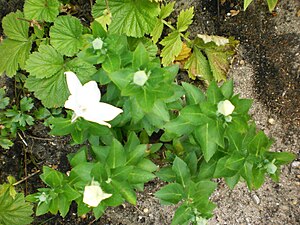Note: This is a project under development. The articles on this wiki are just being initiated and broadly incomplete. You can Help creating new pages.
Platycodon grandiflorum
Platycodon grandiflorus is a herbaceous perennial plant that can grow up to 50cm tall The plant is harvested from the wild for local use as a food and a medicine. The roots are sold as food in local markets in Korea. The plant is cultivated for medicinal use and also sometimes as a food crop. It is often grown as an ornamental.
Uses
Cough, Lowers blood sugar, Colds, Bronchitis, Pleurisy, Pulmonary abscesses, Throat infections, Hypertension, Diabetes.[1]
Parts Used
Chemical Composition
It contains eight compounds were isolated and identified as tangeritin, 3-O-beta-D-glucopyranosylplatycodigenin methyl ester, 3-O-beta-D-glucopyranosylplaticogenic acid A lactone, 3-O-beta-D-glucopyranosylplatycodigenin, deapio-platyconic acid A lactone, deapio-platycodin-D, platycoside-G1 and platycoside-E.[2]
Common names
| Language | Common name |
|---|---|
| Kannada | |
| Hindi | |
| Malayalam | |
| Tamil | |
| Telugu | |
| Marathi | |
| Gujarathi | |
| Punjabi | |
| Kashmiri | |
| Sanskrit | |
| English |
Properties
Reference: Dravya - Substance, Rasa - Taste, Guna - Qualities, Veerya - Potency, Vipaka - Post-digesion effect, Karma - Pharmacological activity, Prabhava - Therepeutics.
Dravya
Rasa
Guna
Veerya
Vipaka
Karma
Prabhava
Habit
Identification
Leaf
| Kind | Shape | Feature |
|---|---|---|
Flower
| Type | Size | Color and composition | Stamen | More information |
|---|---|---|---|---|
| {{{5}}} |
Fruit
| Type | Size | Mass | Appearance | Seeds | More information |
|---|---|---|---|---|---|
Other features
List of Ayurvedic medicine in which the herb is used
Where to get the saplings
Mode of Propagation
How to plant/cultivate
Plants are hardy to about -15°c. Another report says it is hardy to -20°c.[4]
Commonly seen growing in areas
Photo Gallery
References
- ↑ Indian Medicinal Plants by C.P.Khare
- ↑ Chemical constituents
- ↑ [Morphology]
- ↑ Cultivation
External Links
- Ayurvedic Herbs known to be helpful to treat Cough
- Ayurvedic Herbs known to be helpful to treat Lowers blood sugar
- Ayurvedic Herbs known to be helpful to treat Colds
- Ayurvedic Herbs known to be helpful to treat Bronchitis
- Ayurvedic Herbs known to be helpful to treat Pleurisy
- Ayurvedic Herbs known to be helpful to treat Pulmonary abscesses
- Ayurvedic Herbs known to be helpful to treat Throat infections
- Ayurvedic Herbs known to be helpful to treat Hypertension
- Ayurvedic Herbs known to be helpful to treat Diabetes
- Herbs with Young leaves used in medicine
- Herbs with Roots used in medicine
- Habit - Perennial
- Index of Plants which can be propagated by Seeds
- Herbs that are commonly seen in the region of Grassy slopes in hills
- Herbs that are commonly seen in the region of Mountains
- Herbs
- Pages without herbs images





